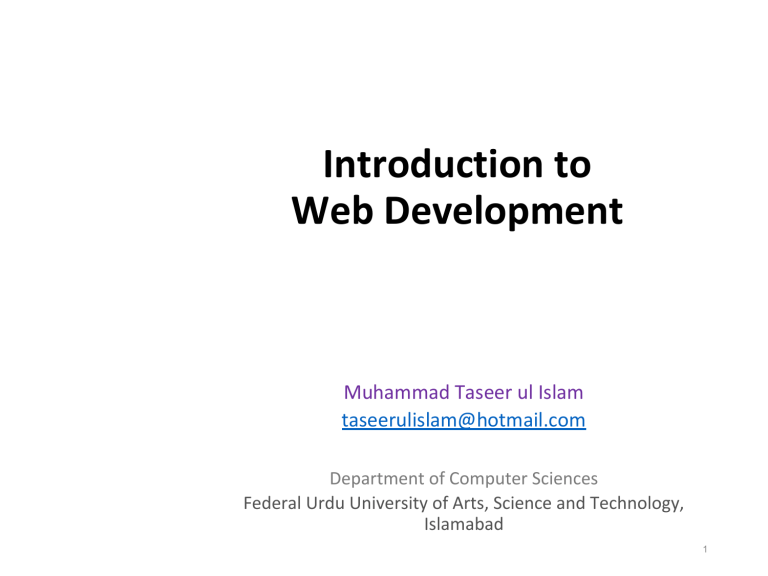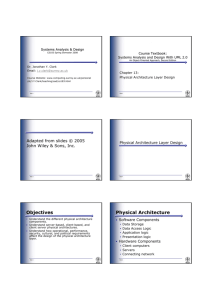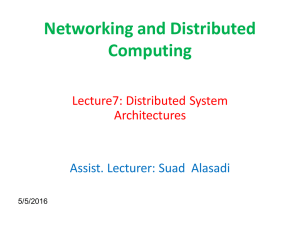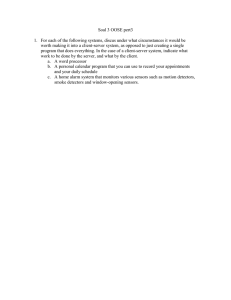
Introduction to Web Development Muhammad Taseer ul Islam taseerulislam@hotmail.com Department of Computer Sciences Federal Urdu University of Arts, Science and Technology, Islamabad 1 Chapter 1 1 A Complicated Ecosystem 3 The Client-Server Model 5 Working in Web Development 2 Definitions and History 4 Where is the Internet? 6 Summary 1 A Complicated Ecosystem 3 The Client-Server Model 5 Working in Web Development 2 Definitions and History 4 Where is the Internet? 6 Summary A Complicated Ecosystem 1 A Complicated Ecosystem 3 The Client-Server Model 5 Working in Web Development 2 Definitions and History 4 Where is the Internet? 6 Summary Definitions and History A Short History of the Internet • Telephone Network • Packet Networks • • • • ARPANET (1969) X.25 (1974) USENET (1979) TCP/IP (1983) INTERNET Definitions and History The Internet and WWW are different (but related) things Definitions and History The Birth of the Web (1990) 1. URLS 2. HTTP 3. SERVERS 4. BROWSERS 5. HTML Definitions and History The Growth of the Internet Definitions and History Web Applications in Comparison to Desktop Applications Advantages: • Accessible from any Internet-enabled computer. • Usable with different operating systems and browser applications. • Easier to roll out program updates since only software on the server needs to be updated as opposed to every computer in the organization using the software. • Centralized storage on the server means fewer security concerns about local storage (which is important for sensitive information such as health care data). Definitions and History Web Applications in Comparison to Desktop Applications Disadvantages: • Requirement to have an active Internet connection (the Internet is not always available everywhere at all times). • Security concerns about sensitive private data being transmitted over the Internet. • Concerns over the storage, licensing, and use of uploaded data. • Restrictions on access to operating system resources can prevent additional software from being installed and hardware from being accessed (like Adobe Flash on iOS). • In addition, clients or their IT staff may have additional plugins added to their browsers, which provide added control over their browsing experience, but which might interfere with JavaScript, cookies, or advertisements. Definitions and History Static Websites versus Dynamic Websites Definitions and History Static Websites versus Dynamic Websites Definitions and History Static Websites versus Dynamic Websites Definitions and History Web 2.0 and Beyond • Web 2.0 Dynamic • Web 2.0 (also known as Participative (or Participatory) and Social Web) refers to websites that emphasize user-generated content, ease of use, participatory culture and interoperability (i.e., compatible with other products, systems, and devices) for end users. • Web 3.0 Semantic • The Semantic Web is an extension of the World Wide Web through standards set by the World Wide Web Consortium (W3C).The goal of the Semantic Web is to make Internet data machine-readable. • To enable the encoding of semantics with the data, technologies such as Resource Description Framework (RDF) and Web Ontology Language (OWL) are used. These technologies are used to formally represent metadata. For example, ontology can describe concepts, relationships between entities, and categories of things. These embedded semantics offer significant advantages such as reasoning over data and operating with heterogeneous data sources.[ • Web Science • • … Web science is an emerging interdisciplinary field concerned with the study of large-scale socio-technical systems, particularly the World Wide Web. It considers the relationship between people and technology, the ways that society and technology co-constitute one another and the impact of this co-constitution on broader society. Web Science combines research from disciplines as diverse as sociology, computer science, economics, and mathematics. Definitions and History Sociotechnological Integration—Web Science 1 A Complicated Ecosystem 3 The Client-Server Model 5 Working in Web Development 2 Definitions and History 4 Where is the Internet? 6 Summary The Client-Server Model The Request-Response Loop The Client-Server Model The Peer-to-Peer Alternative The Client-Server Model Server Types • • • • • • • Web Servers Application Servers Database Servers Mail Servers Media Servers Authentication Servers … The Client-Server Model Real-World Server Installations – Server Farm The Client-Server Model Real-World Server Installations – Server Rack The Client-Server Model Real-World Server Installations – Data Center Randy Connolly and Ricardo Hoar Fundamentals of Web Development - 2nd Ed. 24


